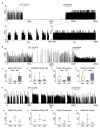Phasic Neuronal Firing in the Rodent Nucleus of the Solitary Tract ex vivo
- PMID: 33762969
- PMCID: PMC7982836
- DOI: 10.3389/fphys.2021.638695
Phasic Neuronal Firing in the Rodent Nucleus of the Solitary Tract ex vivo
Abstract
Phasic pattern of neuronal activity has been previously described in detail for magnocellular vasopressin neurons in the hypothalamic paraventricular and supraoptic nuclei. This characteristic bistable pattern consists of alternating periods of electrical silence and elevated neuronal firing, implicated in neuropeptide release. Here, with the use of multi-electrode array recordings ex vivo, we aimed to study the firing pattern of neurons in the nucleus of the solitary tract (NTS) - the brainstem hub for homeostatic, cardio-vascular, and metabolic processes. Our recordings from the mouse and rat hindbrain slices reveal the phasic activity pattern to be displayed by a subset of neurons in the dorsomedial NTS subjacent to the area postrema (AP), with the inter-spike interval distribution closely resembling that reported for phasic magnocellular vasopressin cells. Additionally, we provide interspecies comparison, showing higher phasic frequency and firing rate of phasic NTS cells in mice compared to rats. Further, we describe daily changes in their firing rate and pattern, peaking at the middle of the night. Last, we reveal these phasic cells to be sensitive to α 2 adrenergic receptors activation and to respond to electrical stimulation of the AP. This study provides a comprehensive description of the phasic neuronal activity in the rodent NTS and identifies it as a potential downstream target of the AP noradrenergic system.
Keywords: brainstem; multi-electrode array; nucleus of the solitary tract; phasic; timekeeping.
Copyright © 2021 Chrobok, Wojcik, Klich, Pradel, Lewandowski and Piggins.
Conflict of interest statement
The authors declare that the research was conducted in the absence of any commercial or financial relationships that could be construed as a potential conflict of interest.
Figures








Similar articles
-
Vasopressin regularizes the phasic firing pattern of rat hypothalamic magnocellular vasopressin neurons.J Neurosci. 1998 Mar 1;18(5):1879-85. doi: 10.1523/JNEUROSCI.18-05-01879.1998. J Neurosci. 1998. PMID: 9465012 Free PMC article.
-
Analysis of intracellularly recorded phasic bursting by mammalian neuroendocrine cells.J Neurophysiol. 1984 Mar;51(3):552-66. doi: 10.1152/jn.1984.51.3.552. J Neurophysiol. 1984. PMID: 6321696
-
Rhythmic activities of hypothalamic magnocellular neurons: autocontrol mechanisms.Biol Cell. 1997 Dec;89(9):555-60. Biol Cell. 1997. PMID: 9673007 Review.
-
Timekeeping in the hindbrain: a multi-oscillatory circadian centre in the mouse dorsal vagal complex.Commun Biol. 2020 May 8;3(1):225. doi: 10.1038/s42003-020-0960-y. Commun Biol. 2020. PMID: 32385329 Free PMC article.
-
Extrinsic modulation of spike afterpotentials in rat hypothalamoneurohypophysial neurons.Cell Mol Neurobiol. 1998 Feb;18(1):3-12. doi: 10.1023/a:1022566924921. Cell Mol Neurobiol. 1998. PMID: 9524726 Free PMC article. Review.
Cited by
-
Vasopressin and Breathing: Review of Evidence for Respiratory Effects of the Antidiuretic Hormone.Front Physiol. 2021 Oct 26;12:744177. doi: 10.3389/fphys.2021.744177. eCollection 2021. Front Physiol. 2021. PMID: 34867449 Free PMC article. Review.
-
Ticking and talking in the brainstem satiety centre: Circadian timekeeping and interactions in the diet-sensitive clock of the dorsal vagal complex.Front Physiol. 2022 Sep 2;13:931167. doi: 10.3389/fphys.2022.931167. eCollection 2022. Front Physiol. 2022. PMID: 36117684 Free PMC article.
-
The role of the prefrontal cortex in cocaine-induced noradrenaline release in the nucleus accumbens: a computational study.Biol Cybern. 2025 Feb 7;119(1):6. doi: 10.1007/s00422-025-01005-5. Biol Cybern. 2025. PMID: 39920377 Free PMC article.
-
Automated analyses for single-fiber electrophysiological recordings using a newly developed Microsoft Excel application and graphical user interface.J Neurosci Methods. 2021 Oct 1;362:109312. doi: 10.1016/j.jneumeth.2021.109312. Epub 2021 Aug 8. J Neurosci Methods. 2021. PMID: 34371025 Free PMC article.
-
From End to End: Gaining, Sorting, and Employing High-Density Neural Single Unit Recordings.Front Neuroinform. 2022 Jun 13;16:851024. doi: 10.3389/fninf.2022.851024. eCollection 2022. Front Neuroinform. 2022. PMID: 35769832 Free PMC article. Review.
References
-
- Armstrong D. M., Pickel V. M., Joh T. H., Reis D. J., Miller R. J. (1981). Immunocytochemical localization of catecholamine synthesizing enzymes and neuropeptides in area postrema and medial nucleus tractus solitarius of rat brain. J. Comp. Neurol. 196, 505–517. 10.1002/cne.901960312, PMID: - DOI - PubMed
LinkOut - more resources
Full Text Sources
Other Literature Sources

